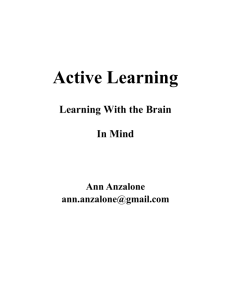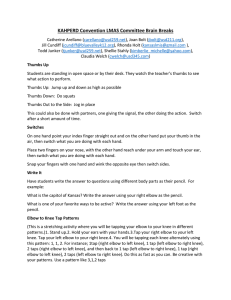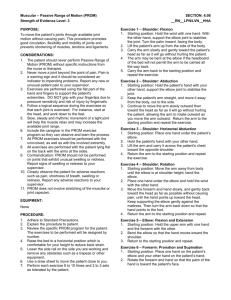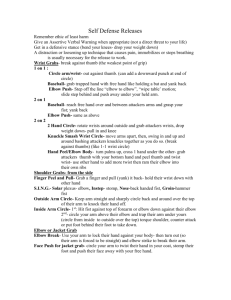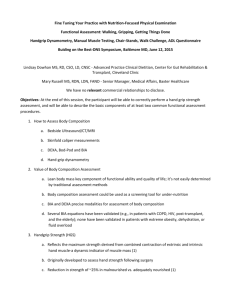Ann-Anzalone-Active-Learning
advertisement
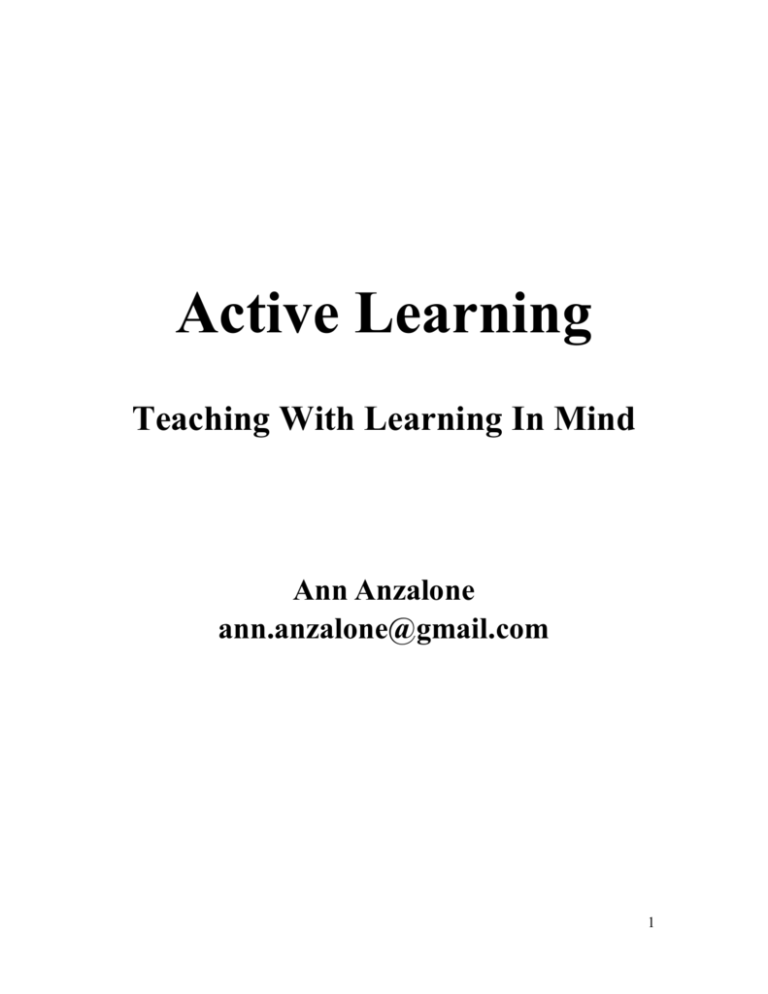
Active Learning Teaching With Learning In Mind Ann Anzalone ann.anzalone@gmail.com 1 GAMES Teach problem solving skills by teaching students to: Plan moves by examining many possibilities Think about consequences of actions Plan ahead more than one step at a time Visualize future moves and to Pay attention ZOOM: Students stand in a circle. One person starts the game by looking to his/her left or right and says, “Zoom.” The next person says “Zoom” to the person next to him/her in the same direction. “Zoom” continues until someone puts the brakes on. Any one in the circle can put the “brakes” on at any time by saying, “Eek!” When “Eek” is said, “Zoom” has to go around the other way. PEANUT BUTTER POINT: Students stand in a circle. One person places his/her hand flat under his/her chin pointing in either direction and says, “Peanut”. The person being pointed to, places an arm over his/her head pointing in either direction and says, “Butter”. The person being pointed to, points to anyone in the circle and says, “Point”. The person being pointed to, places his/her hand flat under his/her chin pointing in either direction and says, “Peanut”. The game continues. If someone is out, he/she becomes a heckler for the players still in the circle. The heckler’s job is to distract the other players so that they also become hecklers. Continue playing until 1or 2 players remain in the circle. The brain wires itself up through play. Stuart Brown, M.D. LITERACY teach literacy: song, dance, play, joking, improvisation, recitation, hear stories, made-up or read aloud; retell; learn to speak well, increase vocabulary through rhetorical practice Good readers grow out of good reciters and good speakers. young people talk themselves into a wholeness; they hear out loud how they feel; without practice in storytelling inner life never fills out and takes shape; by swapping stories a person learns he does not have to accept things as they are; can conjure up his/her own world and manipulate it to his/her own liking fewer children enter the world of orality; it is harder to learn to read because children haven’t practiced or been taught the art of oral recitation; they learn orality by imitation and participation; reading and writing must be learned; practice begins in orality Literacy is the transformation of speech into a visual act. Barry Sanders. A is for Ox Violence, Electronic Media, and the Silencing of the Written Word. New York: Pantheon Books, 1994. 2 CEREBRAL CORTEX MIDBRAIN BRAIN STEM Survival Aggressive: physical and verbal Cannot sit still Clothes-sucking and shirt turning Constantly going to the bathroom Easily distracted Hyperactive Pencil chewing Speech difficulties Tears Arms disappear in clothing Itchy eyes Off task Does not finish work Everything is boring Knee-sitters and chair rockers Perfectionist Stressful reading Trouble with boundaries Debra Wilson Heiberger and Margot C. Heiniger-White. S’cool Moves for Learning. 3 Integrating Both Sides of the Brain The Cross Crawl 2x a day Sit down. Do 28 puppet movements. (Puppet movements touch the elbow of the right arm to the right knee and the elbow of the left arm to the left knee.) Do 28 crossover movements. (Crossover movements touch the elbow of the right arm to the left knee and the elbow of the left arm to the right knee.) Do 14 puppets Do 14 crossovers Do 10 puppets Do 10 crossovers The Wayne Cook Posture Sit down. Fold hands. The thumb of the hand that is on top is the ankle to cross on top. Extend arms and cross the arm of the thumb on top over the other arm. Point thumbs down. Wave at the fingers. Fold hands. Draw hands to chest, like a pretzel. Take ten deep breathes with the tongue on the roof of the mouth to breathe in, down to breathe out. Uncross ankles, put fingertips together. Rest hands with finger tips touching on lap. Take ten more breathes. Donna Eden, Energy Medicine, New York: Jeremy P. Tarcher/Putnam, 1998. Thymus Thump Rapidly, tap chest on both sides of the collar bone at the same time. Resets the body’s balance. Water Weight divided by 3 = number of ounces needed daily # of ounces divided by 8 = number of glasses of water needed daily Lack of water is the #1 trigger of daytime fatigue. Preliminary research indicated 8-10 glasses of water a day could significantly ease back and joint pain for up to 80% of sufferers; 5 glasses per day decreases risk of colon cancer by 45%, slashes risk of breast cancer by 79% and decrease bladder cancer by 50% Fruit juice, soft drinks, coffee and tea are all diuretics—they fail to provide neutral pH water because the sugars bind to the water and are treated as food by the brain. Carla Hannaford, Ph.D. Smart Moves: Why Learning Is Not All In Your Head. Utah: Great River Books. 2005. 4 Human Bingo Directions: Play cover all. Find someone who can do each of the following and write his/her name in the square. You may write one “free” wherever you choose. Likes to read several books at a time Sings Likes to do one thing at a time Journals Remembers names Watches the news Before going to sleep Watches movies more than once Likes to read only one book at a time Remembers faces Fidgets Keeps piles on the desk Likes video games Does yoga Gardens Draws Exercises regularly 5 The Importance of Writing Handwriting affects the ability to read, spell and comprehend. Dr. Rosa Hagin 2002 Ability to write fluently connects to the ability to speak fluently. Writing solidifies thinking and takes reasoning to a higher level. Kathleen Ricards Hopkins Teaching How to Learn in a What-to-Learn Culture Language is the key to making connections. Oral language directs and develops thinking processes. Vygotsky Thoughts and Language Writing is the doing part of thinking. When writing, one is processing what heard or read. Bonnie Terry Thinking: TAPS Tell; Ask; Processes; Steps make questions the medium for connections; ask open ended questions Why and How trump who, what when, where train observational skills using succinct verbal responses tell stories, fables, riddles, proverbs put words in categories Study grammar to build mental competency. Vygotsky knowing how to categorize words in parts of speech leads to flexibility of thinking and ease of expression note likenesses and differences; skills of comparison are one of most powerful learning tools identify what happened before and what might happen after Read aloud and stop to discuss the information. Before children learn how to effectively read silently, they need to master the ability to read and comprehend aloud. Dr. Robert Mellilo Competence is a cognitive skill; Confidence is an emotional or affective quality. 6 Brain Speed a key to learning success Brain speed is how fast the brain processes what is going on, around and within you determines attention, alertness, learning, memory, decision making, problem solving, mental clarity determines how efficiently the mind works. reflects how quickly memories can be recalled, questions answered, problems solved and decisions made. the faster your brain processing speed, the more focused you are, the more you take in and learn, the more you remember, the quicker you make sound, splitsecond decisions and react the faster you can mentally recite or rehearse long list of items, the better you remember Brain speed exercise is the antidote to brain stress. Joshua Reynolds, Robert Heller, M.D, and Christine Macgenn Rodgerson. Living Longer Thinking Younger. CA: BriteAge Corp. 2005-2007. Play games like: Jeopardy, Concentration, Memory, Boggle (www.wordsplay.net), Scrabble, Set (set daily puzzle www.setgame.com) Work puzzles, word searches, Sudoku Answer Questions www.freerice.com Do mental math. Memorize poems. Make ABC lists. Read aloud. Practice Brain Age games (www.memory-improvement-tips.com) Speed stack cup stacking eye-hand program www.speedstacks.com Exercise Brain Gym Infinity Walk Bal-A-Vis-X Learning Breakthrough #1 predicator of success: how much one practices Talent Is Overrated. What Really Separates World-Class Performers from Everybody Else. Geoff Colvin. Deliberate practice hard requires concentration is designed to improve performance with a teacher’s help builds mental models requires repetition provides lots of feedback on results 7 A SELECTED BIBLIOGRAPHY Amen, Daniel, M.D. Making a Good Brain Great. NY: Harmony Books. 2005. Bradley, Michael. Yes, Your Teen Is Crazy! WA: Harbor Press. 2002. Birkenbihl, Vera. Memory Optimizer. MN: Learning Strategies Corp. 2001. Dennison, Paul E. and Gail E. Dennison. Brain Gym. Teacher's Edition Revised. CA: Edu-Kinesthetics Inc. 2010. Freed, Jeffrey and Laurie Parsons. Right-Brained Children in a Left-Brained World. New York: Simon and Schuster. 1997. Hannaford, Carla. Smart Moves. Why Learning Is Not All In Your Head. Virginia: Great River Books. 2005. Healy, Jane M. Endangered Minds: Why Our Children Don't Think. New York: Simon and Schuster. 1999. Hopkins, Kathleen Ricards. Teaching How to Learn in a What-to-Learn Culture. CA: JosseyBass. 2010. Jensen, Eric. Brain Based Learning: The New Paradigm of Teaching. CA: Corwin Press. 2008. Lemov, Doug. Teach Like A Chamnpion. 49 Techniques That Put Your Students On the Path to College. CA: Jossey-Bass. 2010. Melillo, Robert. Dr. Disconnected Kids. New York: Penguin Group. 2009. O’Dell, Nancy PhD. and Patricia Cook PhD. Stopping ADHD. New York: Avery Publishing Group, Inc. 2004. Ratey, J. John. M.D. with Eric Hagerman. SPARK The Revolutionary New Science of Exercise and the Brain. N.Y. Little, Brown and Co. 2008. Scheele, Paul R. and Cheryl Hiltibran. Memory Optimizer Accelerator. MN: Learning Strategies Corp. 2004. Sousa, David EdD. How the Brain Learns to Read. CA: Corwin Press. 2005. Sousa, David A. et al. Mind, Brain, & Education. IN: Solution Tree Press. 2010. Sunbeck, Deborah, Ph.D. Infinity Walk. California: Jalmar Press. 1996. Walsh, David. PhD. Smart Parenting, Smarter Kids. NY: Free Press. 2011. 8 9
